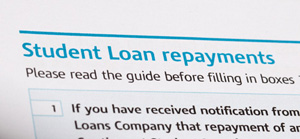Options for Repaying Student Loans

Eventually you have to pay back your student loans. The day comes when you graduate, get a job and must begin making payments on your debt.
Each federal loan must be re-paid according to the terms you agreed to when accepting the loan.
However, there are options like consolidating your student loans as well as forgiveness programs that may be available to you.
This article touches on the following options; repayment plans, student loan consolidation, loan forgiveness, and loan relief.
When It’s Time to Talk About Student Loan Repayment Plans
 The federal education loans will have one of five repayment plans including; standard repayment, extended repayment, graduated repayment, income contingent repayment, and income based repayment.
The federal education loans will have one of five repayment plans including; standard repayment, extended repayment, graduated repayment, income contingent repayment, and income based repayment.
Standard Repayment
This repayment plan requires you to pay your loan off within 10 years. Each monthly payment is a fixed amount with a $50 minimum. It applies to student and parent loans.
Extended Repayment
The extended repayment plan allows the loan term for payoff to be extended to 12 to 30 years. The length of the extension depends on the amount of money borrowed. The longer payment period will result in you paying more in interest of course though the monthly payment amount will be lower. The additional interest amount can be substantial if you double or triple your repayment term from 10 to 20 or 30 years. It applies to student and parent loans.
Graduated Repayment
A graduated federal student loan repayment program is a plan where you pay a lower monthly payment the first two years. Every two years the payment is then adjusted upward.
- Loan term may be 12 to 30 years
- Minimum payment must be at least 50% of the standard repayment amount
- Maximum payment cannot be more than 150% of the standard repayment amount
- Minimum payment must be at least $25 or the accrued interest amount, whichever is higher
This federal student loan repayment plan is designed to help new college graduates by allowing lower payments when starting a new career upon graduation. The assumption is that income will rise over a period of time and the loan repayment amount can be periodically increased. It applies to student and parent loans.
Income Contingent Repayment
The income contingent repayment plan calculates a monthly payment based on the student or parent’s income depending on who is the borrower. The purpose of this repayment plan is to encourage students to pursue lower paying jobs in public service job.
The monthly student loan repayment amount is based on:
- Income
- Total amount borrowed
- Family size
The amount is reviewed each year and the payment changed based on changes in income earned or family size. The maximum repayment term allowed is 25 years and this loan agreement can only be made with the U.S. Department of Education. If the loan is not paid within 25 years, any remaining balance is forgiven.
You can include more than one loan in this repayment plan. The interest rate is fixed, but in the case of multiple loans the rate will represent the weighted average of interest rates for all the loans included in the plan.
There is also an Income Sensitive Repayment plan which bases the monthly federal student loan repayment amount on a percentage of gross income earned each month. The repayment terms extend up to 10 years.
Both the Income Contingent and Income Sensitive Repayment plans apply only to student loans.
Income Based Repayment
One of the newest student loan repayment programs is the Income Based Repayment plan. The monthly payment amount is based on income, but the student loan income based repayment rule sets a cap that references a lower percentage of income than the Income Contingent Repayment and Income Sensitive Repayment plans. It applies only to student loans.
Your student loan repayment rate determines how quickly you will pay off the loan and how much interest you will pay. There is no penalty for prepayment and you can accelerate the principal reduction by making payments that exceed the required monthly amount. You are also allowed to change plans by meeting certain conditions relating to the remaining term of the existing loan.
The many repayment plans available for student loans are designed to help you avoid default on your loans. You should never skip payments. If you cannot make a payment then you should work with the federal loan agency or lender to find a solution. The federal government is ready to help those who honestly need financial help.
One Big Bundle with a Student Loan Consolidation
 It is quite common for a student financial aid package to include several loans. Student may fund their tuition, fees, and room and board with a mixture of federal loans that include the Stafford loan, the FSEOG, Parent PLUS loans, Perkins Loans and others. Many students also obtain private loans. It is possible to consolidate the loans and lower your payment and the interest rate so that monthly payments are more affordable.
It is quite common for a student financial aid package to include several loans. Student may fund their tuition, fees, and room and board with a mixture of federal loans that include the Stafford loan, the FSEOG, Parent PLUS loans, Perkins Loans and others. Many students also obtain private loans. It is possible to consolidate the loans and lower your payment and the interest rate so that monthly payments are more affordable.
Same Amount but Easier Payments!
Students and/or parents may decide to consolidate student loan debt in order to make repayment of the multiple loans more affordable. Since so many students and parents have to take out multiple loans to pay for college, the loan consolidation option can offer big financial benefits. It should be noted that only loans from single borrowers can be consolidated.
The benefits of the student loan consolidation can include the following:
- Can lower the monthly payment by extending the payment terms
- May reduce the total interest amount paid over the life of the loans
- Can lower the average interest rate paid
- Makes loan payment more convenient
- Can choose to consolidate only those loans that bring financial benefit
- No penalties for prepayment
- No fees are charged for federal consolidation loans
You can pick the loans you want to consolidate and roll them into a single loan amount. The interest rate you will pay depends on the lender, your credit rating and the amount of the loan. Depending on your credit rating, a cosigner may or may not be needed.
Choose a Consolidation Program That Suits Your Purposes
There are two student loan consolidation programs. There are consolidation loans offered by private lenders but some have interest rate calculations that are determined by the government if federal loans are involved. There are also federal consolidation loans available through the U.S. Department of Education.
Federal Loan Consolidation – Allows you to consolidate all federal loans into a single amount and extend the payment period beyond the standard 10 years allowed on the individual loans. The interest rate calculation is defined by the federal government even when a private lender consolidates the loan. The interest rate is the weighted average of the interest rates on your current federal loans to be consolidated with a cap of 8.25%. You can also negotiate for repayment terms that fit your budget.
Private Consolidation Loans – Allows you to consolidate federal and/or private loans. If you choose to consolidate federal loans in a private consolidation loan you will lose the generous federal terms related to deferment or forbearance. The student loan consolidation companies will work with you to establish an affordable repayment plan that may include fixed monthly payments or repayment on a graduated basis as your income increases. Though there is no cap on the interest rate like there is for the federal consolidation loan, it is still possible to lower the overall interest rate paid. The length of repayment can be extended which can significantly lower your monthly payment.
After graduation, you have a short period of time to begin repaying your loans. That can present financial difficulties when you have accumulated many loans over the length of your college career. Consolidating the loans will lower your monthly payment so you are not faced with large monthly payments as you are beginning your first job.
Understanding Interest Rates
The student loan consolidation rates for interest are calculated by figuring the weighted average of the interest rates on the loans being consolidated. The student loan consolidation rate for federal loans rolled into a single loan is rounded up to the nearest 1/8 of one percent. The maximum interest rate is 8.25%.
The benefit you get from the weighted average of interest rates depends what interest rates you are paying on the individual loans. It is important to understand that the average interest rate may not save you money on interest paid in total unless the lender is willing to adjust the average interest rate downward. There is a cap on the interest rate but there is no minimum rate.
Manage Your Student Loans
The consolidation of a student loan can make your loans much more manageable at a time you are trying to establish yourself financially. Too many students fall behind on their loans and decide to borrow against their credit cards. It is much better to get student loan consolidation help through your local bank or credit union or the federal government.
Loan Forgiveness
 When you have student loans there are ways to get all or part of the loan forgiven. The goal of the student loan forgiveness programs is to encourage public service in various defined ways. The service can take different forms including as volunteer work, non-profit positions and teaching to name a few.
When you have student loans there are ways to get all or part of the loan forgiven. The goal of the student loan forgiveness programs is to encourage public service in various defined ways. The service can take different forms including as volunteer work, non-profit positions and teaching to name a few.
Volunteer Service
Federal student loan forgiveness is available for specific types of volunteer work. The government programs that offer loan forgiveness include AmeriCorps, the Peace Corps and Volunteers in Service to America (VISTA).
If you serve at least 12 months with AmeriCorps, you can receive a $7,400 stipend and a $4,725 loan payment.
If you join the Peace Corps as a volunteer, federal loans can be deferred and partially forgiven at a rate of 15% for each year of volunteer work. The maximum amount that can be forgiven is 70%.
VISTA volunteers work with the poor, homeless and illiterate. If you volunteer for 1700 hours of service, you can earn $4,275 to be used as a loan payment
The volunteer student loan forgiveness programs are designed to encourage volunteer work
Public Loan Forgiveness Service
The newest federal student loan forgiveness program was created by the College Cost Reduction and Access Act of 2007. This program will lead to debt forgiveness after you work 10 years in a public service job. Other requirements include:
- Must make at least 120 loan payments on a Federal Direct Loan
- Payments made after 10/1/2007 count towards the 120 loan payments
- Deferment and forbearance periods do not count towards the 120 loan payments
- Must be employed in a public service position during the period the 120 loan payments are made
Military Service
The National Guard offers a $10,000 Student Loan Repayment Program. You must contact the National Guard to find out if you are eligible for this program.
Legal and Medical Studies
Yet another student loan forgiveness program is tied to law and medical study programs. You can find out more about the various loan repayment assistance programs at Equal Justice Works and the American Bar Association. These forgiveness programs are managed by the individual law schools so that should be your first point of contact.
There are also a number of loan repayment assistance programs for medical students. Following is an example of the types of student loan forgiveness opportunities:
- National Health Service Corps (U.S. Department of Health and Human Services)
- Nursing Education Loan Repayment Program (U.S. Department of Health and Human Services)
- NIH Loan Repayment Programs (National Institutes of Health)
- Veterinary Medicine Loan Repayment Program (U.S. Department of Agriculture)
There are many others and a good place to begin searching for additional opportunities is through the colleges and universities, medical professional groups, medical foundations and national health agencies. In addition, when looking for a job you should ask medical facilities if they have a loan forgiveness program.
Many of the student loan forgiveness program requirements include working in an economically disadvantaged area or with special needs groups.
Teaching
Partial forgiveness of a student loan is possible for teachers who work in schools located in low-income areas. The National Defense Education Act allows for forgiveness of 15% of the Perkins Loan for each of the first 2 years of service. In the third and fourth years, 20% of the loan can be forgiven each year. For the fifth year, 30% of the loan is forgiven.
The U.S. Department of Education offers a number of teacher loan forgiveness programs.
You can check with the American Federation of Teachers for additional student loan debt forgiveness programs.
Other Routes to Forgiveness
There are many other programs for student loan forgiveness.
- Cancellation of Perkins and Stafford loans for working in designation jobs serving children, families, the disabled and others (U.S. Department of Education)
- Federal Student Loan Repayment Program gives federal agencies the right to create forgiveness programs so they may attract qualified employees
- Math and science teachers teaching in high need secondary schools can have part of their Stafford loans forgiven
- State loan forgiveness programs for those working in medical fields or law enforcement
There are many different loan forgiveness programs and the ones listed are just a sample. You have to shop around for the loan forgiveness programs because there is not a single location where they are all listed. A good place to start is by contacting the college or university financial aid office. You can also contact the federal and state education agencies.
Student Loan Relief…Thanks…I Needed That!
 Millions of students discover at some point they cannot make their loan payments. Unfortunately there are hundreds of thousands who simply quit paying rather than finding out if they qualify for student loan debt relief. Debt relief programs give you a chance to take a breather of sorts while you get your finances back in order or until you are able to find a job.
Millions of students discover at some point they cannot make their loan payments. Unfortunately there are hundreds of thousands who simply quit paying rather than finding out if they qualify for student loan debt relief. Debt relief programs give you a chance to take a breather of sorts while you get your finances back in order or until you are able to find a job.
The reasons people fall behind in their loan payments are as numerous as the stars in the sky. Common reasons include being unable to find a job, too much credit card debt, loss of a job, unexpected major expenses, military service or even a disability. Most of these reasons will qualify you for loan relief, but having too much debt is normally not one of them. But if you are unable to make your loan payments for any reason, it is critical that you contact the lender or the college which issued the loan.
There are three main student loan relief programs; deferment, return to school, and forbearance.
Deferment
A student loan deferment is a program that allows you to skip making loan payments for a defined period of time. You do not have to pay interest on the loan during that time if you have a loan that is one of the following:
- Subsidized Direct or FFEL
- Stafford loan
- Federal Perkins Loan
If your loan is unsubsidized then you must pay the interest either as it is accrued or through interest capitalization.
The three most common reasons that qualify students for loan deferments include returning to school, economic hardship and inability to find a job. But other reasons include maternity, public service or disability. Student loan debt relief through public service refers to those who serve in the military or public health, or join the Peace Corps.
The military service deferment applies to those who are called into active duty for war or a national emergency. The economic hardship deferment can be effective for up to 3 years.
Return to School
If you return to school at least half time then you may request relief from student loan debt. People who lose their jobs or graduating students who are unable to locate work sometimes re-enroll in a degree program. While attending school you can ask for loan relief. But keep in mind that you will have to pay for your new classes which will increase your debt if you borrow the money.
Forbearance
Student loan forbearance is slightly different from a deferment. When you do not qualify for a deferment, you can request forbearance. Your loan payments are postponed but interest continues to accrue no matter what type of loans you owe. Forbearance is granted for economic hardship, some types of disability or other issues. Forbearance is approved by the loan servicer.
The one thing you should never do is let your loan go into default due to lack of payment. No matter the amount of college debt student loan relief can provide important financial help when you are having financial problems.


